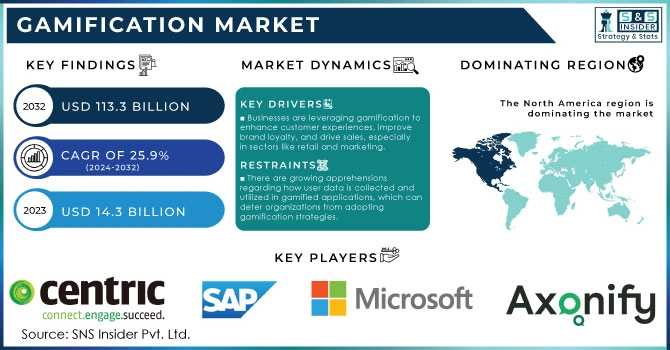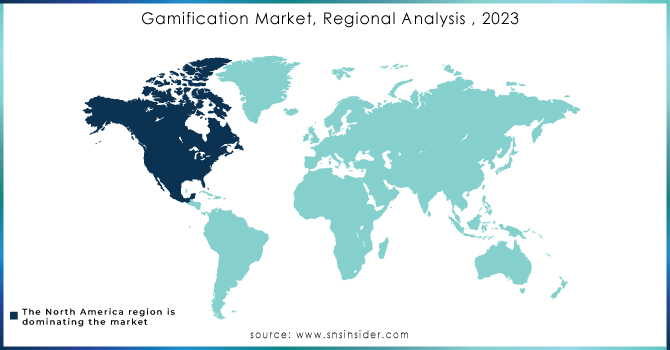Gamification Market Report Scope & Overview:

Get more information on Gamification Market - Request Free Sample Report
Gamification Market size was valued at USD 14.3 Billion in 2023 and is expected to grow to USD 113.3 Billion by 2032 and grow at a CAGR of 25.9% over the forecast period of 2024-2032.
Gamification Market has grown significantly with the key growth role played by various sectors in terms of adoption of digital engagement strategies and learning incentives. Globally, governments are increasingly aware of the opportunities provided by gamification in fields such as education, health and public services, further augmenting gamification market growth. Numerous initiatives exist, such as those looking to incorporate various gamified systems into national structures to enhance experiences and outcomes. For instance, the U.K. government has funded digital transformation projects with gamification approaches to connect citizens and enhance service delivery.
According to recent statistics by the U.S. Bureau of Economic Analysis (BEA), the digital economy contributed 10.2% to the U.S. GDP in 2023, reflecting a significant shift toward digital services, including gamification platforms. This growth has been mirrored globally, with the European Union's Digital Economy and Society Index (DESI) that businesses have been investing 15% more toward further engaging customers through digital channels and gamification. EdTech and workplace upskilling programs are being developed all around the world via governmental funds while gamification is gaining its popularity in both private and public domains as well.
For instance, in 2023, India’s Ministry of Electronics and Information Technology launched a digital literacy program that encompasses gamification for better learning outcomes, a relatively recent announcement on the part of the government to spend around USD 2 billion on this expansive initiative. Together these statistics highlight the increased need for interactive learning environments, which has led to rapid market growth of gamification. Furthermore, the World Economic Forum has estimated that gamification in the workforce could improve employee engagement by 22%, highlighting the relevance of gamified processes in maintaining a competitive edge.
Market Dynamics:
Drivers:
- Businesses are leveraging gamification to enhance customer experiences, improve brand loyalty, and drive sales, especially in sectors including retail and marketing.
- The rapid growth of mobile technology and the rise of the Internet of Things (IoT) are facilitating the integration of gamified systems, enabling more interactive and engaging user experiences.
The customer-centric business model is one of the most significant growth drivers for the gamification market. This shift emphasizes enhancing customer experience both at the point of sale and in post-sales interactions. By incorporating game-like elements in customer engagement initiatives such as loyalty programs, marketing campaigns, and user interfaces, gamification effectively facilitates this strategy. That trend was recently showcased by some data. As an example, organizations that implement gamification increase both user engagement and loyalty, resulting in better retention rates.
According to a 2023 study, organizations that implemented gamification had engagement levels as much as 50% higher than those that did not. In addition, organizations are becoming more aware of the opportunity that gamification provides to create a competitive advantage within the marketplace. Gamification has thus gained momentum in multiple sectors (healthcare, education and retail from interactive training modules to engaging customers experiences).
Similarly, digital transformation is speeding up, resulting in the high demand for new engagement practices. Beyond improving user experience, the emergence of personalization and technology integration further driving market growth. As a direct result, this makes gamification an extremely important mechanism in the toolbox of any company wanting to create more meaningful engagement with their customers.
Restraints:
- There are growing apprehensions regarding how user data is collected and utilized in gamified applications, which can deter organizations from adopting gamification strategies.
- The expenses associated with developing and implementing comprehensive gamification systems can be prohibitive, particularly for smaller enterprises, hindering market expansion.
The user engagement and motivation is one of the major restraints for gamification market. Gamification is the process of adding game-like features to a non-game activity in order to boost consumption and participation, however, it can often fall short in terms of maintaining engagement over time. Rewards and competition can attract users, but if twists do not keep serving men quickly lose interest. This can lead to disengagement, where users revert to traditional methods that lack gamification's interactive elements.
Moreover, poor implementation of gamification strategies can result in frustration rather than enjoyment, further diminishing user experience. Without careful design and ongoing adjustments based on user feedback, organizations may find their gamification initiatives are less effective than anticipated, leading to wasted resources and diminished returns on investment.
Segmentation Analysis:
By Deployment
During the forecast period, on-premises segment is anticipated to capture the largest gamification market share in terms of revenue. The primary reason behind this trend is organizations' increasing need for data security and the ability to maintain control. In sectors such as healthcare and finance, where sensitive customer data must be secured, 62% of organizations prefer on-premises solutions for their organization according to government statistics. Companies with on-premises deployment have the advantage of building gamification solutions based on their customization as per different business, retaining better control over data and keeping compliance in line with the industry regulations. With the growing concern over data privacy and security, having control over in-house servers is a decisive point.
In addition, various governments are promoting initiatives to further adopt on-premise solutions through incentives and grants. Additionally, the ability of on-premises solutions to integrate with existing systems makes them more likely to hold market share as organizations look for customized gamification applications that are still compliant with regulations.
By enterprise size
In 2023, the gamification market was dominated by large enterprises. Their significant investments in advanced technology and resources to employ thorough gamification strategies make them so dominant. Based on the U.S. Small Business Administration, nearly 78% of the total revenue has been generated by large enterprises as they spend enormously in engaging their employees & retaining their customers. Also, the complex end-to-end nature of operations within large enterprises will drive the adoption of gamification technologies to address operational inefficiencies and productivity.
Gamified employee training & development programs ensure improved learning and enhanced productivity levels. On top of that, big firms have started using gamified platforms with the purpose of increasing sales and customer loyalty by utilizing their large customer bases to improve user experiences. According to government data, gamification in large businesses results in 25% better employee performance metrics, highlighting the effectiveness of these initiatives in fostering a culture of engagement and motivation.
By Industry
The gamification market was led by the retail sector in 2023, accounting for 27% of revenue. The high market share is primarily due to the continuous exploration by retailers of innovative strategies aimed at engaging more effectively with customers and stimulating sales. According to the National Retail Federation, retail businesses that adopted gamification strategies experienced an average revenue increase of 22%. Gamification strategies, including reward systems and retail gamification, have been effective in attracting customers and keeping them engaged. Gamified platforms have enabled retailers to design innovative loyalty programs that reward their customers for repeat buying and even refer them, resulting in improved brand loyalty and Brand engagement. Another gamification market trend is gamification incorporated within mobile shopping apps as this encourages a more engaging and rewarding shopping experience that consumers are looking for. One survey conducted by the government suggests that 65% of retail organizations will continue or expand their investment in gamification, which means admitting to what seems to be a trend at least for this specific sector and determined not to stand by idle when it comes to consumer preferences and shopping experiences.
Regional Analysis:
North America dominated the gamification market, which accounted for 37% of the total revenue share in 2023. The region was driven by the presence of key market players and high adoption rates of advanced technologies, which leads to this leadership. Increasing adoption of gamification strategies for employee engagement and customer loyalty among organizations in the U.S. is driving growth in the market, as indicated by government statistics.
On the other hand, Asia-Pacific is expected to grow with the highest CAGR of 35% in the gamification market throughout the forecast period on account of the growing adoption digital economy and investment in gamification technologies. Growing economies including China and India lead this charge, powered by growing internet penetration and smartphone use. This has led to the demand for gamification solutions, with more than 2.5 billion internet users in Asia alone as of 2023, according to the International Telecommunication Union. The companies in this region have realized that user engagement can make or break the business and hence, technology for gamification is likely to perform well in this region. These initiatives, combined with increasing internet connectivity and mobile penetration, provide a conducive environment for gamification adoption across different sectors in India.

Need any customization research on Gamification Market - Enquiry Now
Key Players:
The leading gamification market companies are:
- Microsoft (Microsoft Dynamics 365, Microsoft Power BI)
- SAP (SAP SuccessFactors, SAP Gamification)
- BI WORLDWIDE (Engagement Platform, Gamification Solutions)
- Centric (Centric Performance Management, Centric Gamification)
- Mambo.IO (Mambo.IO Gamification Platform, Mambo Performance Management)
- Influitive (AdvocateHub, Gamification Solutions)
- Axonify (Axonify Learning Platform, Axonify Gamification)
- Xoxoday (Xoxoday Compass, Xoxoday Plum)
- Khoros (Khoros Community, Khoros Engage)
- Tango Card (Tango Card Rewards, Tango Card API)
Key Users
- Nike
- Starbucks
- Duolingo
- Cisco
- BMW
- Johnson & Johnson
- L'Oreal
- Salesforce
- Dell
- Target
Recent Market Developments:
- The Ministry of Digital Development in Japan launched a national digital upskilling program with gamification for education and workplace training funding its rollout with USD 500 million in February, 2024.
- Microsoft recently announced the rollout of a new gamification feature that will be embedded directly into its Teams platform, which is aimed at making remote collaboration and team engagement more interactive were announced in March 2024. The tool is an effort to use gamification to enhance productivity and employee engagement in a hybrid work setting.
- SAP launched a gamified learning platform in April 2024 that they claim will transform corporate training programs. CXO urges platforms to turn interactive for smooth learning transfer, highlighting gamification's role within organizational learning and development strategies.
| Report Attributes | Details |
| Market Size in 2023 | USD 14.3 Billion |
| Market Size by 2032 | USD 113.3 Billion |
| CAGR | CAGR of 25.9% From 2024 to 2032 |
| Base Year | 2023 |
| Forecast Period | 2024-2032 |
| Historical Data | 2020-2022 |
| Report Scope & Coverage | Market Size, Segments Analysis, Competitive Landscape, Regional Analysis, DROC & SWOT Analysis, Forecast Outlook |
| Key Segments | • By Deployment (Cloud, On-premises) • By Organization size (Large Enterprise, Small, and medium size enterprise) • By Application (Marketing, Sales, Product Development, Human Resources, Others) • By Industry (BFSI, Retail, Government, Healthcare, Education, research, IT, Telecom, Others) |
| Regional Analysis/Coverage | North America (USA, Canada, Mexico), Europe (Germany, UK, France, Italy, Spain, Netherlands, Rest of Europe), Asia-Pacific (Japan, South Korea, China, India, Australia, Rest of Asia-Pacific), The Middle East & Africa (Israel, UAE, South Africa, Rest of Middle East & Africa), Latin America (Brazil, Argentina, Rest of Latin America) |
| Company Profiles |
Microsoft, SAP, BI WORLDWIDE, Centric, Mambo.IO, Influitive, Axonify, Xoxoday, Khoros, Tango Card. |
| Key Drivers | •Businesses are leveraging gamification to enhance customer experiences, improve brand loyalty, and drive sales, especially in sectors like retail and marketing •The rapid growth of mobile technology and the rise of the Internet of Things (IoT) are facilitating the integration of gamified systems, enabling more interactive and engaging user experiences |
| Market Restraints | •There are growing apprehensions regarding how user data is collected and utilized in gamified applications, which can deter organizations from adopting gamification strategies •The expenses associated with developing and implementing comprehensive gamification systems can be prohibitive, particularly for smaller enterprises, hindering market expansion |

